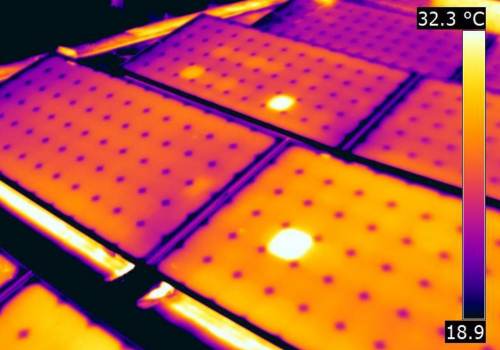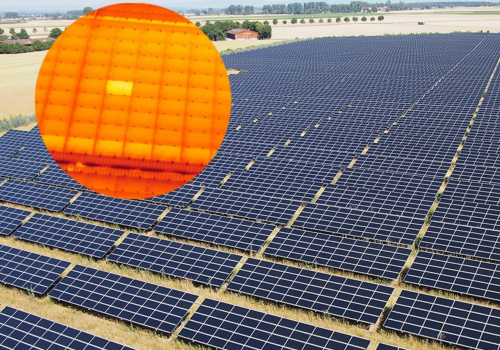Aerial Drone Inspection allows data acquisition from hard-to-reach areas quickly, decreases various risks and costs, and reduces the workforce required on-field.In the past few years, drones have emerged as an essential tool in the energy sector too. Drones are being utilised in one of the biggest industry, Solar Power Areas. Continuous growth of the solar industry brings an ever-expanding base of solar installations.
The failure-free operation of the panels is a prerequisite for efficient power generation, long life, and a high return on investment. Over time, solar panels may develop defects which can be easily fixed if detected in time, but can cause a severe drop in energy production and in some cases even start a fire if left unchecked. For better and faster inspections, aerial solar inspection is a great way to deal with failures and fault checks.
The UTILIZATION and APPLICATIONS

The need of high scale production, management and development have been a essential purpose in many of the industries and companies and so are being covered and inspected by the high-tech drones along with the Solar Areas. UAV technology are now used for solar farm Inspection, Monitoring, and large-scale maintenance. Precise solar farm inspection with the UAVs can spot cell defects, cell failure, dirt on Photovoltaic cells, Interconnection failure, Degradation of solar cells, Decrease of operational efficiency, etc.
Geo Tagged image data Helps to locate faulty panels and failed solar cells easily in large solar farms through the drone features.
Higher-resolution visual Inspections with drone cameras gives a better and higher visual compared to ground-based inspections. Identify potential solar plant issues with HD Inspection reports. Work with the highest quality module data collected using advanced drone mounted sensors and cameras.
Thermal Imaging
The thermal imaging is a technology where a sensor is used to convert the radiation into a visible light picture. Not only does this picture help us identify objects in total darkness, or through dense smoke, but the sensor information can be used to measure temperature differences as well. Thermal cameras detect temperature by recognizing and capturing different levels of infrared light.


The hotter an object is, the more infrared radiation it produces. Thermal cameras can see this radiation and convert it to an image that we can then see with our eyes. In the solar inspection, thermal mapping helps to detect the temperature of the solar panes and hence can save the panes from overheating and bursting by technical faults.
New DJI video highlights impressive drone solar inspection : Click here
Efficiency Through Drones
Automating the way planning, building, and maintaining sustainable energy sources, in a faster, cheaper, and safer manner than humans ever could; drones nowadays are offering unimaginable possibilities to revolutionize energy industries. Solar power among other renewable energy projects has been the preferred source of energy.
Reduced cost of installation over the past decades (which was around 73% earlier) is one of the major reasons for the large adoption of solar solutions.In addition to safety and efficiency, drones also allow for more frequent monitoring. Not only are they an ideal choice for time-critical inspections, but they also enable more strategic planned maintenance.

Increase efficiency – Drones collect data 97% faster than the manual method.
Better Data Collection: Drones efficiently identify the issues that manual processes might miss.
Reduced risk and man-hours: With drones, surveys and inspections can be conducted without traversing expansive terrain.
Improve asset productivity: Drones identify issues early to make informed decisions.
Processing Data Efficiently: Drones help in managing data with a secure online portal, convenient reporting, and an in-field repair app.
See increasing solar inspection efficiency with drones: Click here
Data Analysis
To analyse and post-process the data particular software is required to perform the actions. There are various software for aerial solar inspection, some of them are:
-SolarGain Platform: SolarGain is designed especially for solar plants, utilising machine learning technology to produce detailed and accurate plant health reports.Seamlessly access, share, filter and compare multiple inspection reports. Utilise SolarGain’s data analytics tools to transform your data into actionable insights.
-EyeSite App: EyeSite automatically generates an inspection report within SolarGain saving your time and energy. Easily review visual inspection data to assess the information captured and prioritise your next steps. Create punch list tasks instantly from your inspection report to carry out further remedial work. Update the status of an anomaly from the inspection list.
See the top picks of solar inspection drones of 2021-2022: Click here
Conclusion
To sum up, drones have already started making a huge difference in the planning, construction, and operational phases of solar power plants and solar farms.Along with drone-powered solutions, the renewable energy sector is not just sustainable but also unstoppable.
By employing drones in the renewable energy sector, firms can preserve their assets’ goodwill and sustain energy output through timely and precise solar panel inspections. UAV Technology on-site yields valid, real-time, and cost-efficient inspection data instantly.
Increased efficiency, improved quality and volume of data, avoiding dangerous working hours, reduced costs, storing, tracking, and efficiently distributing data are the advantages of using drone survey technology in solar power plants. There is a range of benefits that are persuading solar farm owners to adopt drone technology and ease the process of setting and maintaining the solar power plant.

